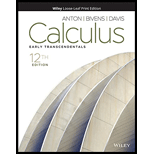
Express the vector v as the sum of a vector parallel to b and a vector orthogonal to b.
Want to see the full answer?
Check out a sample textbook solution
Chapter 11 Solutions
Calculus: Early Transcendentals
Additional Math Textbook Solutions
Calculus: Early Transcendentals (2nd Edition)
Probability And Statistical Inference (10th Edition)
Intro Stats, Books a la Carte Edition (5th Edition)
A Problem Solving Approach To Mathematics For Elementary School Teachers (13th Edition)
Elementary Statistics
Algebra and Trigonometry (6th Edition)
- Take this test to review the material in Chapters 4and Chapters 5. After you are finished, check your work against the answers in the back of the book. Write w=(7,2,4) as a linear combination of the vectors v1, v2 and v3 if possible. v1=(2,1,0), v2=(1,1,0), v3=(0,0,6)arrow_forwardConsider the vector v=(1,3,0,4). Find u such that a u has the same direction as v and one-half of its length. b u has the direction opposite that of v and twice its length.arrow_forward
- Algebra & Trigonometry with Analytic GeometryAlgebraISBN:9781133382119Author:SwokowskiPublisher:Cengage
 Trigonometry (MindTap Course List)TrigonometryISBN:9781337278461Author:Ron LarsonPublisher:Cengage Learning
Trigonometry (MindTap Course List)TrigonometryISBN:9781337278461Author:Ron LarsonPublisher:Cengage Learning Elementary Linear Algebra (MindTap Course List)AlgebraISBN:9781305658004Author:Ron LarsonPublisher:Cengage Learning
Elementary Linear Algebra (MindTap Course List)AlgebraISBN:9781305658004Author:Ron LarsonPublisher:Cengage Learning  Trigonometry (MindTap Course List)TrigonometryISBN:9781305652224Author:Charles P. McKeague, Mark D. TurnerPublisher:Cengage Learning
Trigonometry (MindTap Course List)TrigonometryISBN:9781305652224Author:Charles P. McKeague, Mark D. TurnerPublisher:Cengage Learning Linear Algebra: A Modern IntroductionAlgebraISBN:9781285463247Author:David PoolePublisher:Cengage Learning
Linear Algebra: A Modern IntroductionAlgebraISBN:9781285463247Author:David PoolePublisher:Cengage Learning Elementary Geometry For College Students, 7eGeometryISBN:9781337614085Author:Alexander, Daniel C.; Koeberlein, Geralyn M.Publisher:Cengage,
Elementary Geometry For College Students, 7eGeometryISBN:9781337614085Author:Alexander, Daniel C.; Koeberlein, Geralyn M.Publisher:Cengage,





